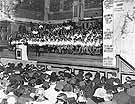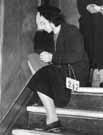
|
|
|

|

|

|

|
|
Click on an image to see a larger, more detailed picture.
|
|
|
|
|
| 1938: The End of Illusions |

|
pg. 134 |

|
|
|
|
| |
 Growing persecution fueled the conviction among some German Jews that their future lay in a Jewish homeland. Others remained rooted in Germany but sought to further Jewish cultural renewal and to strengthen solidarity among Jews. Theologian, scholar, and community leader Martin Buber launched an ambitious program of education to offset Jewish expulsion from German schools and universities. Here he addresses the Berlin Jewish community during "Palestine Week." An ardent Zionist, Buber emigrated to Palestine in 1938.
Growing persecution fueled the conviction among some German Jews that their future lay in a Jewish homeland. Others remained rooted in Germany but sought to further Jewish cultural renewal and to strengthen solidarity among Jews. Theologian, scholar, and community leader Martin Buber launched an ambitious program of education to offset Jewish expulsion from German schools and universities. Here he addresses the Berlin Jewish community during "Palestine Week." An ardent Zionist, Buber emigrated to Palestine in 1938.
Photo: Bildarchiv Abraham Pisarek
|
 This poster proclaims that America "challenges antisemitism and race hatred." However, many--perhaps most--Americans were not willing to help Europe's Jews. A 1939 Gallup poll reported that the majority of Americans opposed increasing immigration quotas for Jewish refugees.
This poster proclaims that America "challenges antisemitism and race hatred." However, many--perhaps most--Americans were not willing to help Europe's Jews. A 1939 Gallup poll reported that the majority of Americans opposed increasing immigration quotas for Jewish refugees.
Photo: National Museum of American Jewish History
|
 Driven Across Borders
Driven Across Borders
During the 1930s it was still possible for Germany's Jews to emigrate. Yet sadly, there were few places to go. Most countries were unwilling to admit Jews, fearing they would become social and economic burdens. By 1938 the number of Jews seeking refuge abroad increased tremendously. The Anschluss, Germany's annexation of Austria, was accompanied by the humiliation, torture, arrests, and expropriation of Austrian Jews. Thousands attempted to flee for the borders of Czechoslovakia, Hungary, Poland, and Switzerland, filling trains and congesting roads with cars and taxis. The Anschluss also marked the beginning of the Nazi policy of expulsion by force. Some Jews were beaten, stripped of their belongings, put onto dilapidated boats, and pushed down the Danube River frontier. In October 1938, 17,000 Polish-born Jews living in Germany were rounded up, loaded aboard sealed railroad cars, and illegally driven across the Polish border by SS guards. Finding shelter in a small frontier village, thousands crowded into pigsties, stables, and warehouses. Although the Poles initially attempted to force them back, most of the refugees were reluctantly admitted. Kristallnacht ignited further panicked emigration to Palestine, Britain, the Americas, and war-torn Shanghai, China. Some hastily fled eastward via the Soviet Trans-Siberian Railroad. Others frantically accepted passage aboard rickety, unseaworthy ships.
Photo: National Archives/United States Holocaust Memorial Museum Photo Archive
|
|

|

|

|

|
 August 18, 1938: Romanian Orthodox Church Patriarch Miron Cristea calls upon the nation "to fight the Jewish parasites."
August 18, 1938: Romanian Orthodox Church Patriarch Miron Cristea calls upon the nation "to fight the Jewish parasites."
|
 August 18, 1938: The Swiss government denies entry to Jews. However, Paul Grüninger, local police commandant of St. Gall on the Austrian frontier, disobeys his superiors and allows 3600 Jews to pass the border from August through December 1938.
August 18, 1938: The Swiss government denies entry to Jews. However, Paul Grüninger, local police commandant of St. Gall on the Austrian frontier, disobeys his superiors and allows 3600 Jews to pass the border from August through December 1938.
|
 August 26, 1938: In Vienna, the Central Office for Jewish Emigration (Zentralstelle für Jüdische Auswanderung) is set up under Adolf Eichmann.
August 26, 1938: In Vienna, the Central Office for Jewish Emigration (Zentralstelle für Jüdische Auswanderung) is set up under Adolf Eichmann.
|
|
|
|
|
| 1938: The End of Illusions |

|
pg. 134 |

|
|
The Holocaust Chronicle
© 2009 Publications International, Ltd.
|
|
